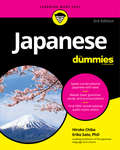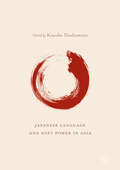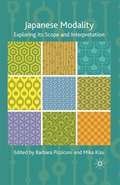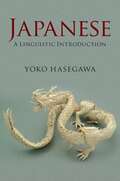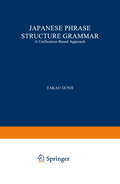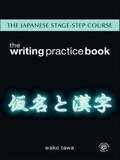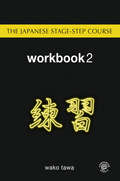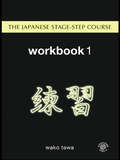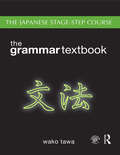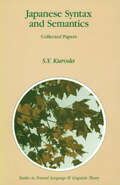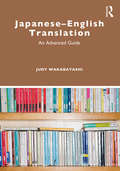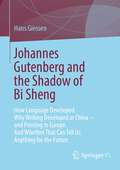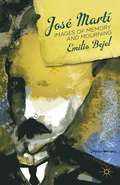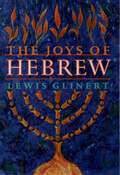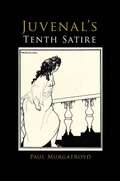- Table View
- List View
Japanese: A Comprehensive Grammar
by Stefan Kaiser Yasuko Ichikawa Noriko Kobayashi Hilofumi YamamotoJapanese: A Comprehensive Grammar is a thorough reference guide to modern Japanese grammar. With its detailed treatment of all grammatical structures, it explores the complexities of the language fully, concentrating on the real patterns of use in contemporary Japanese as spoken and written by native speakers. This edition has been fully updated throughout, incorporating a new structure now organised by topic and providing specific attention to areas of particular difficulty. Examples have been updated throughout to reflect current usage and a glossary of linguistic terms has been added. Features include: Clear grammar points put into context using examples from a range of Japanese media Inclusive coverage of both colloquial and standard Japanese Extensive cross-referencing in all parts of the book A detailed index of Japanese and English terms Written by experts in this field, Japanese: A Comprehensive Grammar will be an essential reference source for the learner and user of Japanese at all levels.
Japanese: A Comprehensive Grammar
by Stefan Kaiser Yasuko Ichikawa Noriko Kobayashi Hilofumi YamamotoJapanese: A Comprehensive Grammar is a thorough reference guide to modern Japanese grammar. With its detailed treatment of all grammatical structures, it explores the complexities of the language fully, concentrating on the real patterns of use in contemporary Japanese as spoken and written by native speakers. This edition has been fully updated throughout, incorporating a new structure now organised by topic and providing specific attention to areas of particular difficulty. Examples have been updated throughout to reflect current usage and a glossary of linguistic terms has been added. Features include: Clear grammar points put into context using examples from a range of Japanese media Inclusive coverage of both colloquial and standard Japanese Extensive cross-referencing in all parts of the book A detailed index of Japanese and English terms Written by experts in this field, Japanese: A Comprehensive Grammar will be an essential reference source for the learner and user of Japanese at all levels.
Japanese For Dummies (For Dummies)
by Hiroko M. Chiba Eriko SatoLearn to speak Japanese Japanese language enrollment is up by 27.5 percent since 2006, making it the sixth most popular language studied on college campuses. Whether studying for school, business, or travel, Japanese For Dummies provides complete coverage of all Japanese language essentials including grammar, usage, and vocabulary. Complete with free conversational audio tracks online, this handy book offers everything you need to learn the Japanese language to get ahead in class or on a trip to Japan. In no time, you’ll make sense of the language well enough to communicate with native speakers! Includes expanded coverage of grammar, verb conjugations, and pronunciations Provides a refreshed mini-dictionary with even more essential vocabulary Offers useful exercises and practice opportunities Helps you learn to speak conversational Japanese with ease Whether for work, school, or fun, Japanese For Dummies is the fast and easy way to add this language to your skillset!
Japanese For Dummies
by Hiroko M. Chiba Eriko SatoLearn to speak Japanese Japanese language enrollment is up by 27.5 percent since 2006, making it the sixth most popular language studied on college campuses. Whether studying for school, business, or travel, Japanese For Dummies provides complete coverage of all Japanese language essentials including grammar, usage, and vocabulary. Complete with free conversational audio tracks online, this handy book offers everything you need to learn the Japanese language to get ahead in class or on a trip to Japan. In no time, you’ll make sense of the language well enough to communicate with native speakers! Includes expanded coverage of grammar, verb conjugations, and pronunciations Provides a refreshed mini-dictionary with even more essential vocabulary Offers useful exercises and practice opportunities Helps you learn to speak conversational Japanese with ease Whether for work, school, or fun, Japanese For Dummies is the fast and easy way to add this language to your skillset!
Japanese Language and Soft Power in Asia
by Kayoko HashimotoThis cutting edge collection considers how the Japanese language functions as a key element of Japanese soft power in Asia. Within Japanese culture itself, the promotion of language has been an area of ambivalence. This interdisciplinary book looks across the fields of language policy, language teaching, socio-linguistics, cultural studies and history to identify the links between Japan’s language policies and broader social, economic and political processes. It examines the challenges that undermine Japan’s potential soft power by identifying a gap between the “official Japan” portrayed by the Japanese government and the “cultural Japan” that foreigners perceive. It also reveals historical continuity in the way Japanese language is perceived and promoted by policy makers and how the current practices of Japanese language teaching in Asian countries have been shaped within the framework of “international exchange”, which has been a key concept in Japanese foreign policies since the 1970s. It particularly considers the concept of ‘Cool Japan’ as a symbol of Japan’s interpretation of its cultural power and offers a thoughtful assessment of the future of Japanese as a form of soft power in Asia as the country prepares for the 2020 Tokyo Olympics.
Japanese Modality: Exploring its Scope and Interpretation
by B. Pizziconi M. KizuThis book explores the nature and scope of modality in Japanese. It contains a review of the history of Japanese modality studies, as well as theoretical and empirical research and is the first collection of studies on Japanese modality written in English and offers a stimulating contrast to existing studies on Western languages.
Japanese (PDF): A Linguistic Introduction
by Yoko HasegawaThis comprehensive introduction to the Japanese language consists of six parts. Following the introductory section, it explores the Japanese lexicon, grammatical foundations, major clause types, clause linkage, and language usage. The discussion of formal and structural properties of Japanese such as sound structure, vocabulary and grammar assist readers as they gain insight into historical and sociocultural aspects of Japanese; some are compared with those of English-speaking nations. An ideal choice for instructors, the book includes twenty-eight chapters, sufficient for approximately ninety hours of hands-on instruction. Each topic has been rigorously selected based on the author's experience of more than two decades teaching Japanese linguistics. The book's breadth and depth make it highly appropriate for learners of the Japanese language, for linguistics students interested in Japanese, and for researchers interested in Japanese linguistics. Online resources include exercises and supplementary multimedia materials to enhance the reader's comprehension and enjoyment.
Japanese Phrase Structure Grammar: A Unification-based Approach (Studies in Natural Language and Linguistic Theory #8)
by T. GunjiThis book is a considerable revision and extension of my thesis for The Ohio State University completed in 1981: A Phrase Structural Analysis of the Japanese Language (Gunji 1981a). The book discusses some of the major grammatical constructions of Japanese in a version of phrase structure grammar called Japanese Phrase Structure Grammar (JPSG), which is loosely based on such frameworks for phrase structure grammar as Generalized Phrase Structure Grammar (GPSG) and Head-driven Phrase Structure Grammar (HPSG). Particular emphasis is placed on the binding and control of pronouns (both implicit - "zero" - and explicit ones, including reflexives) in complementation structures (chapter 4) and adjunction structures (chapter 5). Even though this book started as a revision of my 1981 thesis, the resultant book has few traces of my thinking then. The 1981 thesis was closely related to an early version of GPSG, which was then at a very preliminary stage, and I had only a few preprints of papers by Gerald Gazdar and others to read. GPSG itself has evolved during the past. several years, culminating in a book published last year (Gazdar, Klein, Pullum, and Sag 1985), which differs from the early theory in many ways.
Japanese Stage-Step Course: Writing Practice Book
by Wako TawaThe Writing Practice Book provides a step-by-step guide to writing Kana and Kanji. It is designed to give maximum flexibility to users of The Japanese Stage-Step Course and enables students to learn, practice and perfect their writing skills at their own pace. The book is divided into two parts; the first focuses on Kana and the second on Kanji. There are clear instructions on stroke order followed by tracing exercises and plenty of boxes are provided for additional practice. Kanji are gradually introduced in sets and are accompanied by the Japanese readings, examples of usage and radicals.
The Japanese Stage-Step Course: Workbook 2
by Wako TawaWorkbook 2 of the Japanese Stage-Step Course is designed to be used alongside Stages Two and Three of the Grammar Textbook. It contains conversation, listening, reading and writing exercises along with new vocabulary for each lesson in the textbook to enable students to thoroughly practice the grammatical structures they have learnt. Additional features include: detailed explanation of vocabulary items abundant exercises including sentence as well as discourse practices extensive cross-referencing with the Grammar Textbook Japanese–English and English–Japanese glossary. All the audio material for Workbook 2 is available on CD2.
The Japanese Stage-Step Course: Workbook 2
by Wako TawaWorkbook 2 of the Japanese Stage-Step Course is designed to be used alongside Stages Two and Three of the Grammar Textbook. It contains conversation, listening, reading and writing exercises along with new vocabulary for each lesson in the textbook to enable students to thoroughly practice the grammatical structures they have learnt. Additional features include: detailed explanation of vocabulary items abundant exercises including sentence as well as discourse practices extensive cross-referencing with the Grammar Textbook Japanese–English and English–Japanese glossary. All the audio material for Workbook 2 is available on CD2.
Japanese Stage-Step Course: Workbook 1
by Wako TawaWorkbook 1 of the Japanese Stage-Step Course is designed to be used alongside Stage One of the Grammar Textbook. It contains grammar exercises, along with new vocabulary and conversational, listening, and reading practice for each chapter in the textbook, so that students will be able to thoroughly practice the grammatical structures they have learnt. Additional features include: detailed explanation of vocabulary items information on the system of Kanji abundant exercises including sentence as well as discourse practices extensive cross-referencing with the Grammar Textbook Japanese-English and English-Japanese glossary. All the audio material for Workbook 1 is available on CD1.
Japanese Stage-Step Course: Grammar-Reference
by Wako TawaThe Japanese Stage-Step Course is a fully integrated language course from beginner through to intermediate level combining cohesive grammar instruction with functional examples and practices to build a solid foundation in the four key skills of reading, writing, listening and speaking. The course includes the core text, The Grammar Textbook, Workbooks 1 and 2, Writing Practice Book, audio material on CDs or in MP3 format, and a Companion Website. An understanding of grammar is essential for students aiming to achieve a high level of proficiency in Japanese. Written by an experienced teacher, The Stage-Step Course: Grammar Textbook provides a step-by-step guide to Japanese grammar. With clear, accessible explanations and relevant examples to put each grammatical point into context, the Grammar provides a meaningful framework to develop the key skills of reading, writing, speaking and listening. The book is divided into the following four stages: Stage One: Building a foundation. Stage Two: Towards more complex structures. Stage Three: Adding sophistication. Stage Four: Referencing. Each lesson is accompanied by detailed vocabulary, conversation practice and reading exercises in the separate two workbooks to enable students to put into practice what they have learnt and consolidate their knowledge. The course also includes the Writing Practice Book, audio material on CDs or in MP3 format and a Companion Website.
Japanese Stage-Step Course: Grammar-Reference
by Wako TawaThe Japanese Stage-Step Course is a fully integrated language course from beginner through to intermediate level combining cohesive grammar instruction with functional examples and practices to build a solid foundation in the four key skills of reading, writing, listening and speaking. The course includes the core text, The Grammar Textbook, Workbooks 1 and 2, Writing Practice Book, audio material on CDs or in MP3 format, and a Companion Website. An understanding of grammar is essential for students aiming to achieve a high level of proficiency in Japanese. Written by an experienced teacher, The Stage-Step Course: Grammar Textbook provides a step-by-step guide to Japanese grammar. With clear, accessible explanations and relevant examples to put each grammatical point into context, the Grammar provides a meaningful framework to develop the key skills of reading, writing, speaking and listening. The book is divided into the following four stages: Stage One: Building a foundation. Stage Two: Towards more complex structures. Stage Three: Adding sophistication. Stage Four: Referencing. Each lesson is accompanied by detailed vocabulary, conversation practice and reading exercises in the separate two workbooks to enable students to put into practice what they have learnt and consolidate their knowledge. The course also includes the Writing Practice Book, audio material on CDs or in MP3 format and a Companion Website.
Japanese Stage-Step Course: Workbook 1
by Wako TawaWorkbook 1 of the Japanese Stage-Step Course is designed to be used alongside Stage One of the Grammar Textbook. It contains grammar exercises, along with new vocabulary and conversational, listening, and reading practice for each chapter in the textbook, so that students will be able to thoroughly practice the grammatical structures they have learnt. Additional features include: detailed explanation of vocabulary items information on the system of Kanji abundant exercises including sentence as well as discourse practices extensive cross-referencing with the Grammar Textbook Japanese-English and English-Japanese glossary. All the audio material for Workbook 1 is available on CD1.
Japanese Syntax and Semantics: Collected Papers (Studies in Natural Language and Linguistic Theory #27)
by S.-Y. Kuroda1. Two main themes connect the papers on Japanese syntax collected in this volume: movements of noun phrases and case marking, although each in turn relates to other issues in syntax and semantics. These two themes can be traced back to my 1965 MIT dissertation. The problem of the so-called topic marker wa is a perennial problem in Japanese linguistics. I devoted Chapter 2 of my dissertation to the problem of wa. My primary concern there was transformational genera tive syntax. I was interested in the light that Chomsky'S new theory could shed on the understanding of Japanese sentence structure. I generalized the problem of deriving wa-phrases to the problem of deriving phrases accompanied by the quantifier-like particles mo, demo, sae as well as wa. These particles, mo, demo and sae may roughly be equated with a/so, or something like it and even, respectively, and are grouped together with wa under the name of huku-zyosi as a subcategory of particles in Kokugogaku, Japanese scholarship on Japanese grammar. This taxonomy itself is a straightforward consequence of distributional analysis, and does not require the mechanisms of transformational grammar. My transformational analysis of wa, and by extension, that of the other huku zyosi, consisted in formally relating the function of the post-nominal use of wa to that of the post-predicative use by means of what I called an attachment transformation.
Japanese–English Translation: An Advanced Guide
by Judy WakabayashiThis volume is a textbook for aspiring translators of Japanese into English, as well as a reference work for professional Japanese–English translators and for translator educators. Underpinned by sound theoretical principles, it provides a solid foundation in the practice of Japanese–English translation, then extends this to more advanced levels. Features include: 13 thematic chapters, with subsections that explore common pitfalls and challenges facing Japanese–English translators and the pros and cons of different procedures exercises after many of these subsections abundant examples drawn from a variety of text types and genres and translated by many different translators This is an essential resource for postgraduate students of Japanese–English translation and Japanese language, professional Japanese–English translators and translator educators. It will also be of use and interest to advanced undergraduates studying Japanese.
Japanese–English Translation: An Advanced Guide
by Judy WakabayashiThis volume is a textbook for aspiring translators of Japanese into English, as well as a reference work for professional Japanese–English translators and for translator educators. Underpinned by sound theoretical principles, it provides a solid foundation in the practice of Japanese–English translation, then extends this to more advanced levels. Features include: 13 thematic chapters, with subsections that explore common pitfalls and challenges facing Japanese–English translators and the pros and cons of different procedures exercises after many of these subsections abundant examples drawn from a variety of text types and genres and translated by many different translators This is an essential resource for postgraduate students of Japanese–English translation and Japanese language, professional Japanese–English translators and translator educators. It will also be of use and interest to advanced undergraduates studying Japanese.
Japanisch für Dummies (Für Dummies)
by Eriko SatoSie haben angefangen, Japanisch zu lernen, haben regelmäßig Kontakt zu japanischen Geschäftspartnern oder wollen Ihren Urlaub in Japan verbringen? In diesem Buch erfahren Sie alles über die Besonderheiten der Sprache, erhalten eine kurze Einführung in Betonung und Grammatik und lernen anhand von vielen typischen Alltagssituationen Japanisch zu sprechen. So können Sie sich nicht nur auf Japanisch vorstellen und Small Talk betreiben, sondern bekommen auch beim Einkaufen und im Restaurant das, was Sie wollen. Mit der CD zum Buch können Sie viele Sprachübungen anhören und nachsprechen.
Jewish Languages from A to Z
by Aaron D. Rubin Lily KahnJewish Languages from A to Z provides an engaging and enjoyable overview of the rich variety of languages spoken and written by Jews over the past three thousand years. The book covers more than 50 different languages and language varieties. These include not only well-known Jewish languages like Hebrew, Yiddish, and Ladino, but also more exotic languages like Chinese, Esperanto, Malayalam, and Zulu, all of which have a fascinating Jewish story to be told. Each chapter presents the special features of the language variety in question, a discussion of the history of the associated Jewish community, and some examples of literature and other texts produced in it. The book thus takes readers on a stimulating voyage around the Jewish world, from ancient Babylonia to 21st-century New York, via such diverse locations as Tajikistan, South Africa, and the Caribbean. The chapters are accompanied by numerous full-colour photographs of the literary treasures produced by Jewish language-speaking communities, from ancient stone inscriptions to medieval illuminated manuscripts to contemporary novels and newspapers. This comprehensive survey of Jewish languages is designed to be accessible to all readers with an interest in languages or history, regardless of their background—no prior knowledge of linguistics or Jewish history is assumed.
Jewish Languages from A to Z
by Aaron D. Rubin Lily KahnJewish Languages from A to Z provides an engaging and enjoyable overview of the rich variety of languages spoken and written by Jews over the past three thousand years. The book covers more than 50 different languages and language varieties. These include not only well-known Jewish languages like Hebrew, Yiddish, and Ladino, but also more exotic languages like Chinese, Esperanto, Malayalam, and Zulu, all of which have a fascinating Jewish story to be told. Each chapter presents the special features of the language variety in question, a discussion of the history of the associated Jewish community, and some examples of literature and other texts produced in it. The book thus takes readers on a stimulating voyage around the Jewish world, from ancient Babylonia to 21st-century New York, via such diverse locations as Tajikistan, South Africa, and the Caribbean. The chapters are accompanied by numerous full-colour photographs of the literary treasures produced by Jewish language-speaking communities, from ancient stone inscriptions to medieval illuminated manuscripts to contemporary novels and newspapers. This comprehensive survey of Jewish languages is designed to be accessible to all readers with an interest in languages or history, regardless of their background—no prior knowledge of linguistics or Jewish history is assumed.
Johannes Gutenberg and the Shadow of Bi Sheng: How Language Developed. Why Writing Developed in China – and Printing in Europe. And Whether That Can Tell Us Anything for the Future.
by Hans GiessenWithout language, not much else would exist: no writing, no computer – as a matter of fact, no technical or medical progress that make our lives less painful, and easier indeed; but also not some horrors that characterize our world. In fact, language is what defines humans and distinguishes them from other living beings – and is the basis of all other developments. How is it possible that something as complex and fascinating as 'language' has come into being at all? How does language 'work'? And how did it develop? What is common to all languages – and why are there so many? Further questions are how man began to write, and how printing developed – in which languages? Why not in any language? And does this teach us anything for further developments? In trying to answer these and other questions, we experience an exciting history of scientific research.
José Martí: Images of Memory and Mourning
by E. BejelThis book is a critical study of visual representations of José Martí The National Hero of Cuba , and the discourses of power that make it possible for Martí's images to be perceived as icons today. It argues that an observer of Martí's icons who is immersed in the Cuban national narrative experiences a retrospective reconstruction of those images by means of ideologically formed national discourses of power. Also, the obsessive reproduction of Martí's icons signals a melancholia for the loss of the martyr-hero. But instead of attempting to "forget Martí," the book concludes that the utopian impulse of his memory should serve to resist melancholia and to visualize new forms of creative re-significations of Martí and, by extension, the nation.
The Joys of Hebrew
by Lewis GlinertWhen do you say mazal tov? What is the English equivalent to the Talmudic expression Alya ve-kots ba ("a sheep's tail with a thorn in it")? What is a get, a golem, a kibbutz, a chalutz? What four plant species are waved during prayers on the harvest festival of Sukkot? You'll find answers to these questions and hundreds of others--all in clear English--in this remarkable collection of the best known, most loved Hebrew words and phrases in the English speaking world. From Acharon to Zohar, this informative and often humorous dictionary features over six hundred Hebrew words and expressions arranged in alphabetical order (the Roman alphabet is used throughout, as well as Hebrew head words). The first such guide to Hebrew, this volume is more than a mere lexicon--it is a jubilant celebration of Hebrew itself, a treasure trove of Jewish wit, wisdom, culture, and tradition. Lewis Glinert provides a concise definition of each entry, and then illustrates the word's usage with generous passages from the Bible and the Talmud, the prayers and the sayings of famous rabbis, the razor's edge of Jewish humor, excerpts from the work of Elie Wiesel, Adin Steinsaltz, S.Y. Agnon, Martin Buber, Naomi Shemer and other contemporary writers, folklore from all over the Jewish world, and colorful slices of modern Israeli life. There are words directly related to the practice of religion, such as amida (a prayer said standing, under one's breath, essentially a cry for help--for wisdom, health, peace, prosperity, and so forth) as well as the names of all the Jewish holy days and religious customs; words from everyday Jewish experience, such peot (the long sidecurls customarily worn by the Chasidim); many words familiar from their use in Israel, such as rega (literally, "one moment," it is the Israeli equivalent of Mexico's mañana) or miluim (army reserve service); and many traditional sayings, such as Tsarat rabim chatsi nechama ("A public woe is half a comfort"). In addition, Glinert provides at the back of the book an alphabetical list of familiar biblical names in English, Sephardi/Israeli Hebrew, and Ashkenazi Hebrew. This celebration of Hebrew language and culture is a joy to read and to use. Everyone from Bible students to collectors of Judaica, from Woody Allen fans to people planning a journey to the Holy Land, will be delighted by this informative volume.
Juvenal’s Tenth Satire
by Professor Paul MurgatroydThis is not a commentary on Juvenal Satire 10 but a critical appreciation of the poem which examines it on its own and in context and tries to make it come alive as a piece of literature, offering one man’s close reading of Satire 10 as poetry, and concerned with literary criticism rather than philological minutiae. In line with the recent broadening of insight into Juvenal’s writing this book often addresses the issues of distortion and problematizing and covers style, sound and diction as well. Much time is also devoted to intertextuality and to humour, wit and irony. Building on the work of scholars like Martyn, Jenkyns and Schmitz, who see in Juvenal a consistently skilful and sophisticated author, this is a whole book demonstrating a high level of expertise on Juvenal’s part sustained throughout; a long poem (rather than intermittent flashes). This investigation of 10 leads to the conclusion that Juvenal is an accomplished poet and provocative satirist, a writer with real focus, who makes every word count, and a final chapter exploring Satires 11 and 12 confirms that assessment. Translation of the Latin and explanation of references are included so that Classics students will find the book easier to use and it will also be accessible to scholars and students interested in satire outside of Classics departments.


